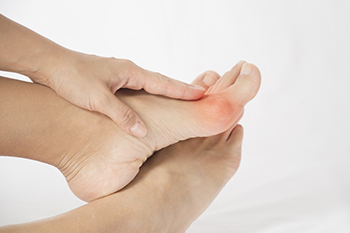
Broomall (484) 521-0233
West Chester (610) 436-5883

Broomall (484) 521-0233
West Chester (610) 436-5883

A bunion is a bony bump that forms on the joint at the base of the big toe. It occurs when the big toe pushes against the next toe, causing the joint to stick out and become misaligned. Common causes include genetics, foot structure, arthritis, and wearing tight or ill-fitting shoes. Symptoms of a bunion include pain, swelling, redness, and restricted movement of the big toe. The area may feel sore or irritated, especially when wearing shoes. Over time, the bump can become more pronounced and painful. A podiatrist can diagnose a bunion through a physical exam and may use X-rays to assess the severity and alignment of the toe joint. Treatment options range from conservative measures like padding, orthotics, and anti-inflammatory medication to surgical correction in more advanced cases. If you are dealing with a painful bunion, it is suggested that you make an appointment with a podiatrist for evaluation and treatment.
If you are suffering from bunions, contact the podiatrists of Dr. Siegerman & Associates. Our doctors can provide the care you need to keep you pain-free and on your feet.
What Is a Bunion?
A bunion is formed of swollen tissue or an enlargement of boney growth, usually located at the base joint of the toe that connects to the foot. The swelling occurs due to the bones in the big toe shifting inward, which impacts the other toes of the foot. This causes the area around the base of the big toe to become inflamed and painful.
Why Do Bunions Form?
Genetics – Susceptibility to bunions are often hereditary
Stress on the feet – Poorly fitted and uncomfortable footwear that places stress on feet, such as heels, can worsen existing bunions
How Are Bunions Diagnosed?
Doctors often perform two tests – blood tests and x-rays – when trying to diagnose bunions, especially in the early stages of development. Blood tests help determine if the foot pain is being caused by something else, such as arthritis, while x-rays provide a clear picture of your bone structure to your doctor.
How Are Bunions Treated?
If you have any questions, please feel free to contact one of our offices located in Broomall and West Chester, PA . We offer the newest diagnostic and treatment technologies for all your foot care needs.